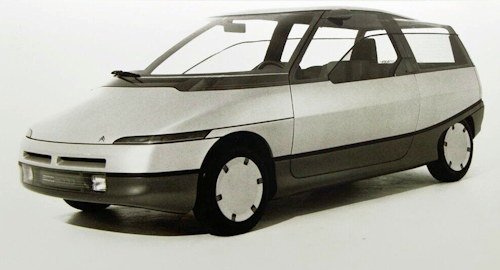Citroën Eco 2000 Concept
 |
|
|
Make |
Citroën |
|
Years of production |
1982 to 1984 |
|
Production |
4 copies |
|
Class |
Concept Car |
|
Energy |
Diesel |
|
Motor (s) |
3 cylinders online |
|
Engine position |
transversal |
|
Displacement |
750 cm 3 |
|
Maximum power |
35 ch |
|
Unloaded weight |
480 kg |
|
Maximum speed |
140 km / h |
|
Mixed consumption |
3.5 L / 100 km |
|
Bodywork |
People Carrier |
|
Frame |
Made of synthetic materials |
|
Coefficient of drag |
0.22 |
|
suspensions |
Hydropneumatic with one sphere per axle (with corrector of plate) |
Citroën Eco 2000 is a Citroën concept car presented at the Paris Motor Show 1984.
History
The Eco 2000 is an economic car project launched in 1981, in response to the two oil crises of 1973 and 1979 . Half financed by the French State , it aims to reduce the average consumption within 3 years to 3 L / 100 km. The working atmosphere leads to concrete experiments, and three prototypes are assembled between 1982 and 1984 .
Efforts focus in particular on three areas :The improvement of the aerodynamics , which gives rise to the creation of 48 models and more than 1500 wind tunnel measurements, leads to innovative solutions, such as a trim system to adapt the Cx according to the speed and the load, or the use of continuous surfaces (flush windows, glued windscreens, etc. ).The reduction of the masses, by the use of a small number of pieces (85, against 288 for a contemporary GSA ), synthetic materials, and computer-aided design (CAD), led to a projected ground mass of about 25 kg / m 2 (42 on average in 1970, and 32.4 for BX in 1982).Lastly, the optimization of the motors, again via the CAD, plays on the reduction of the mechanical masses and on the improvement of the yield.
Three prototypes are built. The first, called SA 103, was released in March 1982. It comes in a form unibody 3.04 m , weighs 430 kg , and can accommodate 4 people via two large side doors. It is powered by a small 2 cylinder engine of 704 cc, and claims, thanks to a Cx reduced to 0.26, only 3.5 L / 100 km in average consumption. But several defects appear: no luggage compartment, reduced impact protection, bad soundproofing.
The successor, SA 119, was produced in March 1983. Equipped with a more conventional design, it is also longer (3.47 m ), and introduces the hydropneumatic suspension . But the weight drops again to 423 kg , and the CX to 0.22, allowing to reach an average consumption of 3.2 L / 100 km.
A synthesis of the work done so far, the third prototype, known as SA 109, appears in March 1984. Now very close to a marketable vehicle, it contains its weight at 450 kg and retains a Cx of 0.22. The engine is a 3-cylinder diesel line 0.75 L mounted in transverse position. It increases average fuel consumption to 3.5 L / 100 km, but achieves a top speed of 140 km / h 1 .
The final version of the Eco 2000, a model based on the SA 109, is presented under the name SL 10 at the Paris Motor Show in 1984. Slightly heavier (480 kg ), it claims a consumption of 2.4 L / 100 km at 90 km / h stabilized, according to UTAC standards .
Although it will never lead to commercialization, some of the solutions developed in the framework of the Eco 2000 project will be taken over later on the Citroën AX .
